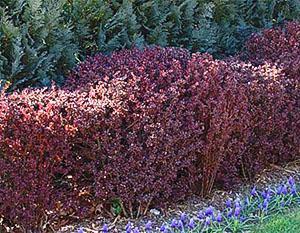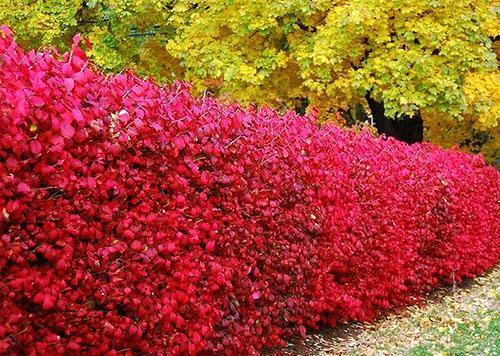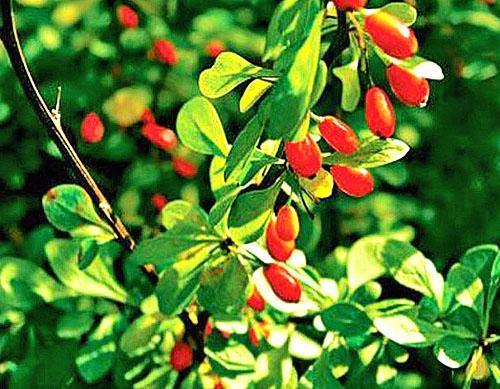What could be more beautiful than a barberry hedge
 Fences and the front gardens faded into the background after the opportunity arose to plant barberries in their summer cottages and vegetable gardens. Photos of barberry in landscape design are amazing. Craftsmen put all their imagination and professional skills into work, bringing to life the most non-trivial ideas of hedges. Green spaces are not only beauty, but also natural protection of cultivated plants from unfavorable climatic conditions.
Fences and the front gardens faded into the background after the opportunity arose to plant barberries in their summer cottages and vegetable gardens. Photos of barberry in landscape design are amazing. Craftsmen put all their imagination and professional skills into work, bringing to life the most non-trivial ideas of hedges. Green spaces are not only beauty, but also natural protection of cultivated plants from unfavorable climatic conditions.
Why exactly barberry?

The advantages of barberry are in the following factors:
- The shrub tolerates low temperatures well. Thanks to this, the plant can be planted even in those regions where there are sharp seasonal temperature drops, including in Siberia.
The best option for regions where there is a sharp drop in temperature in winter is the Ottavsky barberry. This species was bred in Canada. The climate in this country resembles the Russian one, which allows us to speak about the adaptability of the plant.
- The plant is unpretentious in care. All that is required from the gardener is timely pruning of dried branches, as well as trimming the barberry hedge.
- The shrub tolerates a lack or excess of moisture well. The roots do not rot, the leaves do not dry out. Thanks to this, the hedge will look elegant even in places where there is no proper watering.
- Depending on which variety is chosen, the hedge can reach a height of 40 cm to 3 meters.
- Barberry is unpretentious to the ground. Grows well even in poor soils.
What types of barberry are used for landscape design?
Barberry "Ordinary"
 This variety is recognized by gardeners as the simplest and most unpretentious to care for. But, despite this, photos of a decorative barberry allow us to appreciate all its beauty. In April, the shrub is covered with delicate flowers, which add beauty and consistency to the plant. In autumn, the barberry bears fruit. Small oval berries of bright red color perfectly dilute the array of greenery. This variety of barberry is frost-resistant, tolerates drought and waterlogging. It takes root well after transplantation, even in poor soil.
This variety is recognized by gardeners as the simplest and most unpretentious to care for. But, despite this, photos of a decorative barberry allow us to appreciate all its beauty. In April, the shrub is covered with delicate flowers, which add beauty and consistency to the plant. In autumn, the barberry bears fruit. Small oval berries of bright red color perfectly dilute the array of greenery. This variety of barberry is frost-resistant, tolerates drought and waterlogging. It takes root well after transplantation, even in poor soil.
If a high barberry hedge is required, then it is recommended to purchase the "Ordinary" variety. The shrub reaches up to 2, and sometimes 2.5 meters.
Barberry "Thunberg"
 Many gardeners choose the "Thunberg" variety for planting barberry. This is due to the fact that the shrub is not only unpretentious to care for, but also has a colossal variety. The variety is subdivided into several subspecies, each of which is distinguished not only by the height of the bushes, but also by the range of colored leaves. Barberry "Thunberg" bears fruit in small berries, which play only a decorative role.
Many gardeners choose the "Thunberg" variety for planting barberry. This is due to the fact that the shrub is not only unpretentious to care for, but also has a colossal variety. The variety is subdivided into several subspecies, each of which is distinguished not only by the height of the bushes, but also by the range of colored leaves. Barberry "Thunberg" bears fruit in small berries, which play only a decorative role.
The fruits of the "Thunberg" barberry must not be used for food. They contain a large amount of alkaloids, which makes them bitter in taste and inedible.
Barberry "Ottawa"
 This variety is a hybrid, as it was bred by crossing the barberry "Common" and "Thunberg". The homeland of the bush is Canada.Planting barberry "Ottawa" is possible in low temperatures, since the variety is characterized by a high degree of frost resistance. The shrub has a unique color scheme. In the spring and summer, the leaves acquire a beautiful purple color. In autumn, the foliage is colored orange, red and yellow. The plant bears fruit. The berries remain on the branches throughout the fall, which adds brightness and beauty to the shrub. Barberry "Ottawa" reaches a height of 3 meters. The branches are very soft, as the thorns are almost completely absent.
This variety is a hybrid, as it was bred by crossing the barberry "Common" and "Thunberg". The homeland of the bush is Canada.Planting barberry "Ottawa" is possible in low temperatures, since the variety is characterized by a high degree of frost resistance. The shrub has a unique color scheme. In the spring and summer, the leaves acquire a beautiful purple color. In autumn, the foliage is colored orange, red and yellow. The plant bears fruit. The berries remain on the branches throughout the fall, which adds brightness and beauty to the shrub. Barberry "Ottawa" reaches a height of 3 meters. The branches are very soft, as the thorns are almost completely absent.
Barberry "Amur"
 The shrub was bred in the Khabarovsk Territory. Ideal for planting both in the Far East and Central Russia. The shrub has large bright green foliage. In the autumn, the leaves take on a burgundy hue. The spines of this variety of barberry reach a length of 3 cm. That is why the species is considered the best option for creating protective hedges.
The shrub was bred in the Khabarovsk Territory. Ideal for planting both in the Far East and Central Russia. The shrub has large bright green foliage. In the autumn, the leaves take on a burgundy hue. The spines of this variety of barberry reach a length of 3 cm. That is why the species is considered the best option for creating protective hedges.
Barberry "Amursky" bears fruit in the autumn. However, it is worth remembering that unripe berries are poisonous. Only ripe fruits can be eaten.
Barberry care
The shrub is quite unpretentious to care for, but it is prone to numerous diseases that can destroy the hedge. Therefore, gardeners should spray the plant on time to avoid the death of the barberry.
If the barberry is planted as a hedge, then the soil must be fertilized at least once a year. With single plantings, there is no such need.
 Barberry is not recommended to prune for the first two years. It is at this time that the plant is gaining strength for further growth. In the third year of life, you can prune barberry in the fall. Pruning branches that are dry or protruding from the general concept should be trimmed. At this stage, you need to take care of your own safety, since the barberry is prickly and can injure the skin during work. To do this, you need to resort to a regular pruner, and in the best option - a tree pruner.
Barberry is not recommended to prune for the first two years. It is at this time that the plant is gaining strength for further growth. In the third year of life, you can prune barberry in the fall. Pruning branches that are dry or protruding from the general concept should be trimmed. At this stage, you need to take care of your own safety, since the barberry is prickly and can injure the skin during work. To do this, you need to resort to a regular pruner, and in the best option - a tree pruner.
Barberry, regardless of its variety, is susceptible to diseases caused by pests. The flower moth and aphids greatly spoil the appearance of the bush. This can be avoided only with timely spraying with poison. Also, the shrub can be infected with powdery mildew, which appears as white spots on the leaves. If the disease occurs during the growing season, there is a high risk of plant death.
Every gardener should pay special attention to the foliage of the barberry. At the first signs of disease, it is recommended to process the plant. Only in this case the barberry hedge will look attractive, aesthetically pleasing and well-groomed.